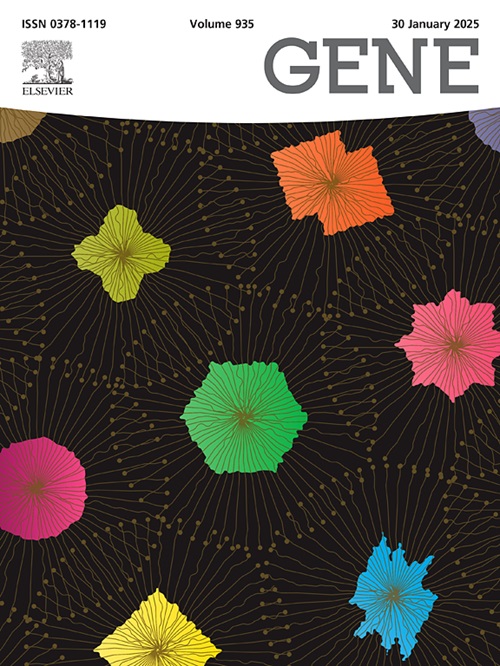Polyphenol oxidase gene editing changed the flavonoid composition and browning process of litchi (Litchi chinensis Sonn.) callus
IF 2.4
3区 生物学
Q2 GENETICS & HEREDITY
引用次数: 0
Abstract
Postharvest pericarp browning, caused primarily by the enzymatic oxidation of phenols, reduces the shelf life and market value of litchi fruit and is considered a major limitation for the development of the litchi industry. Previous studies have shown that polyphenol oxidase (PPO) is a key enzyme and that flavonoids are important substrates for enzymatic browning; however, direct evidence is still lacking. This study investigated the differences in the browning process among the wild type (WT) and four PPO gene-edited litchi calli to verify the function of PPO in the browning of litchi tissues. Compared to the WT callus, the proliferation rate, relative expression of litchi PPO gene (LcPPO), PPO activity and color changes significantly decreased or slowed down in all gene-edited calli, indicating that the latter exhibited a slower browning process. Using a liquid chromatography tandem mass spectrometry approach (LC-MS/MS), 83 metabolites of flavonoids were identified, of which 58 were differentially accumulated metabolites (DAMs). Venn analysis revealed 12 common DAMs across different genotypic contrasts that were mostly enriched in the flavonoid biosynthesis pathway. It was presumed that the decrease of LcPPO expression in gene-edited calli led to the reduced PPO activity, then reduced the (−)-epicatechin oxidation. The accumulation of (−)-epicatechin caused the common upregulation of procyanidin B2 and upstream substances such as dihydrokaempferol, taxifolin, naringenin chalcone, 7,4′-dihydroxyflavone, and rutin in their biosynthesis pathways. The results provide novel evidence that (−)-epicatechin acts as the primary direct substrate in the enzymatic browning reaction mediated by PPO.
多酚氧化酶基因编辑改变了荔枝愈伤组织的类黄酮组成和褐变过程。
荔枝果皮褐变主要是由酚类物质的酶促氧化引起的,它降低了荔枝果实的保质期和市场价值,被认为是制约荔枝产业发展的主要因素。已有研究表明,多酚氧化酶(PPO)是酶促褐变的关键酶,黄酮类化合物是酶促褐变的重要底物;然而,直接证据仍然缺乏。本研究研究了野生型(WT)和PPO基因编辑的4个荔枝愈伤组织褐变过程的差异,以验证PPO在荔枝组织褐变中的作用。与WT愈伤组织相比,所有基因编辑的愈伤组织的增殖率、荔枝PPO基因(LcPPO)的相对表达量、PPO活性和颜色变化均显著降低或减慢,表明后者的褐变过程较慢。采用液相色谱串联质谱法(LC-MS/MS)鉴定了83种黄酮类化合物的代谢物,其中58种为差异积累代谢物(DAMs)。Venn分析显示,在不同的基因型对比中,有12个共同的dam主要富集在类黄酮生物合成途径中。推测基因编辑愈伤组织中LcPPO表达的减少导致PPO活性降低,从而减少(-)-表儿茶素氧化。(-)-表儿茶素的积累导致原花青素B2和上游物质如二氢山奈酚、杉木素、柚皮素查尔酮、7,4′-二羟黄酮、芦丁等生物合成途径的共同上调。结果提供了新的证据,表明(-)-表儿茶素在PPO介导的酶促褐变反应中起主要直接底物的作用。
本文章由计算机程序翻译,如有差异,请以英文原文为准。
求助全文
约1分钟内获得全文
求助全文
来源期刊

Gene
生物-遗传学
CiteScore
6.10
自引率
2.90%
发文量
718
审稿时长
42 days
期刊介绍:
Gene publishes papers that focus on the regulation, expression, function and evolution of genes in all biological contexts, including all prokaryotic and eukaryotic organisms, as well as viruses.
文献相关原料
公司名称
产品信息
索莱宝
polyphenol oxidase activity assay kit
索莱宝
polyphenol oxidase activity assay kit
索莱宝
polyphenol oxidase activity assay kit
 求助内容:
求助内容: 应助结果提醒方式:
应助结果提醒方式:


